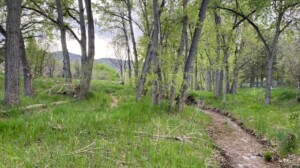Climate change has ushered in a summer of farewells and reintroductions at Point Defiance Park, the 760-acre crown jewel of Tacoma, Washington’s municipal park system.
On May 20, motorized vehicles were permanently banned from traversing the outer loop of Five Mile Drive, a bluff-hugging scenic byway that wraps around the outer tip of the sprawling urban park jutting into the South Puget Sound like an outstretched pinkie finger. The closure ended nearly a century of pleasure driving along the one-way road, which winds counterclockwise through a dense stand of old growth forest within the quieter, wilder “back” of the park located at a remove from the attractions—marina, zoo, formal gardens, and on—clustered closer to the main entrance. Multiple trailheads can be found off the outer loop as can a string of overlooks with commanding clifftop views of Vashon Island, Dalco Passage, and the Tacoma Narrows along with the strait’s pair of titular suspension bridges. Prior to the pandemic, the gates to Five Mile Drive’s outer loop had been closed weekend mornings to motorized traffic for exclusive use by cyclists and pedestrians, both of which can continue to access the road. (When the park reopened, vehicle access as limited to weekdays only.) A total car ban, however, was unprecedented, and the urgency at which the closure took effect surprised some Point Defiance habitués.
Prompting the outer loop’s sudden closure was a geotechnical report commissioned by Metro Parks Tacoma that confirmed erosion and “encroaching instability” on the 250-foot-tall vertical bluffs flanking the narrow road. “Climate change is a global phenomenon that is having a clearly visible effect on shorelines and slopes in the Pacific Northwest, as heavier rain and sea level rise accelerate erosion and landslides,” explained Metro Parks Tacoma, a parks district that operates as an independent entity from the government of the Puget Sound region’s second-most populous city. Heavy vehicles, including school buses, were restricted from entering the 2.5-mile stretch of road ahead of the larger prohibition of motorized traffic.
Five Mile Driver’s inner loop, which houses the park’s marquee attractions including Point Defiance Zoo & Aquarium and the Fort Nisqually living history museum, remains fully open to traffic. Meanwhile, Metro Parks is exploring ways to provide access to the “Outer Loop experience” to visitors reliant of motorized means of transport. “We know how deeply our community feels about this tranquil, forested space,” said Joe Brady, deputy director of Regional Parks and Attractions for Metro Parks Tacoma, in a statement. “But we also take public safety and environmental protection very seriously. This decision is a direct response to the acceleration of erosion caused by multiple forces of nature, and we must respect that inevitable power.”
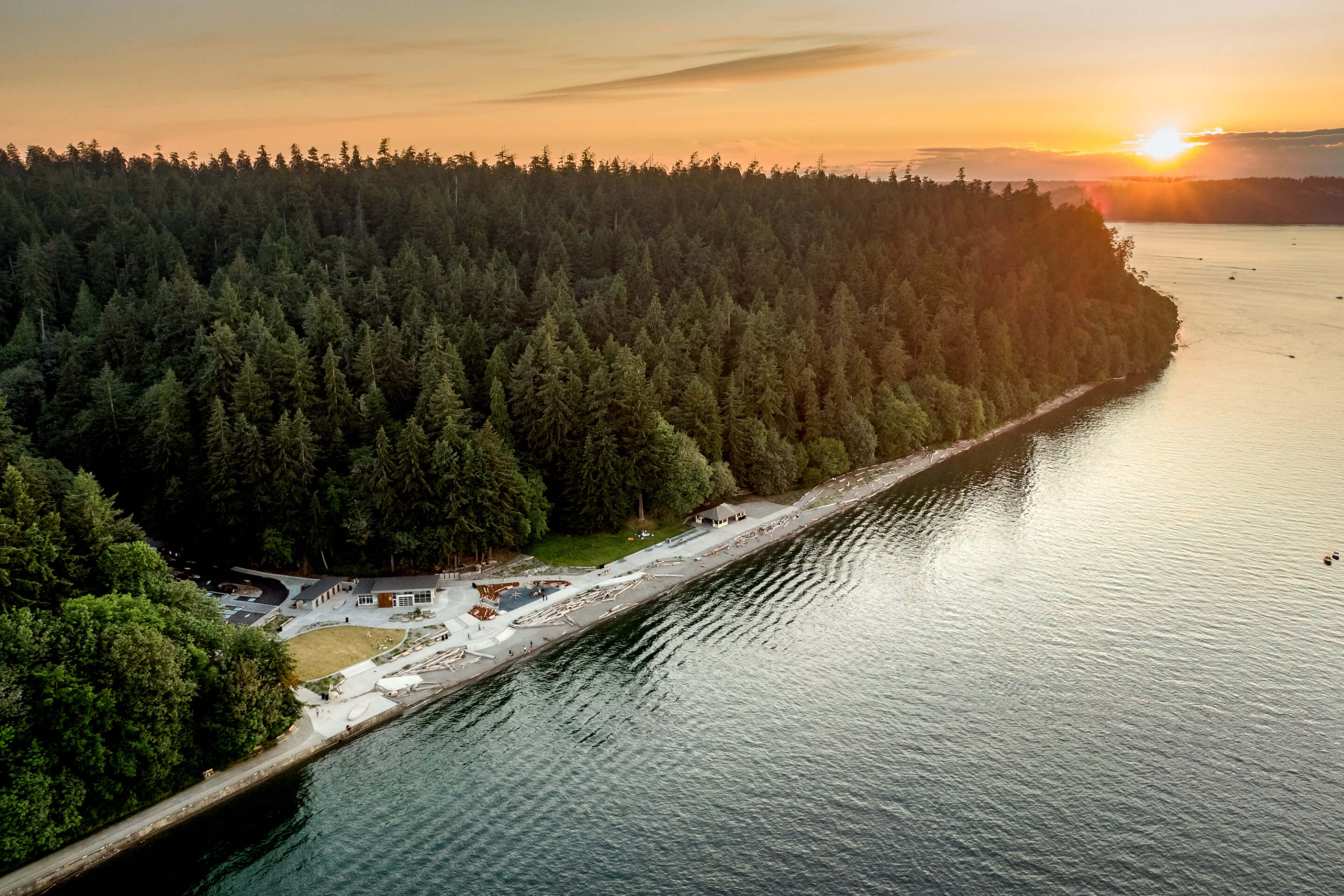
The closure of Five Mile Drive’s outer loop to vehicular traffic was fortuitously timed, coming just days ahead of the highly anticipated reopening of another beloved destination at Point Defiance Park: Owen Beach. Closed since February 2021, Owen Beach reopened on June 4 following a $6.3 million overhaul that was designed not in response to accelerated erosion but another consequence of a warming planet: sea level rise.
Led by Seattle-based landscape architecture and urban planning studio Site Workshop, the revamp of the popular public beach has yielded a slew of amenities, both new and familiar, along with long-needed infrastructural upgrades. Hugging 1,000 feet of shoreline along the Salish Sea, Owen Beach is nestled at the foot of a ravine, not too far from where Five Mile Drive’s inner loop curves back toward the more developed heart of Point Defiance and the outer loop begins.
As Site Workshop principal Clayton Beaudoin told AN, the initial scope of the 16-month project, carried out as part of the 2015 Point Defiance Park Master Plan Update, was focused on renovating existing facilities and upgrading the site’s aging infrastructure; at the time, a larger overhaul based on sea level rise projections simply wasn’t part of the bigger picture. “People love this place–don’t screw it up,” was a guiding mantra as Beaudoin explained.
Visitors who haven’t visited the waterfront hotspot since its closure in early 2021 will find: a reconstructed lawn area, “canoe-inspired” benches, a launch slope for kayaks and other non-motorized watercraft, refreshed landscaping with native plantings, improved restrooms, a renovated WPA-era picnic pavilion, and a modest children’s playscape featuring a climbable wooden orca sculpture. The old bathhouse and concessions building, also a WPA project, has been repurposed into a kayak rental and storage space; closer to the parking lot, a new beach pavilion designed by SHKS Architects houses both a seasonal snack bar and dedicated classroom space for the Science and Math Institute, a public high school located within the park.

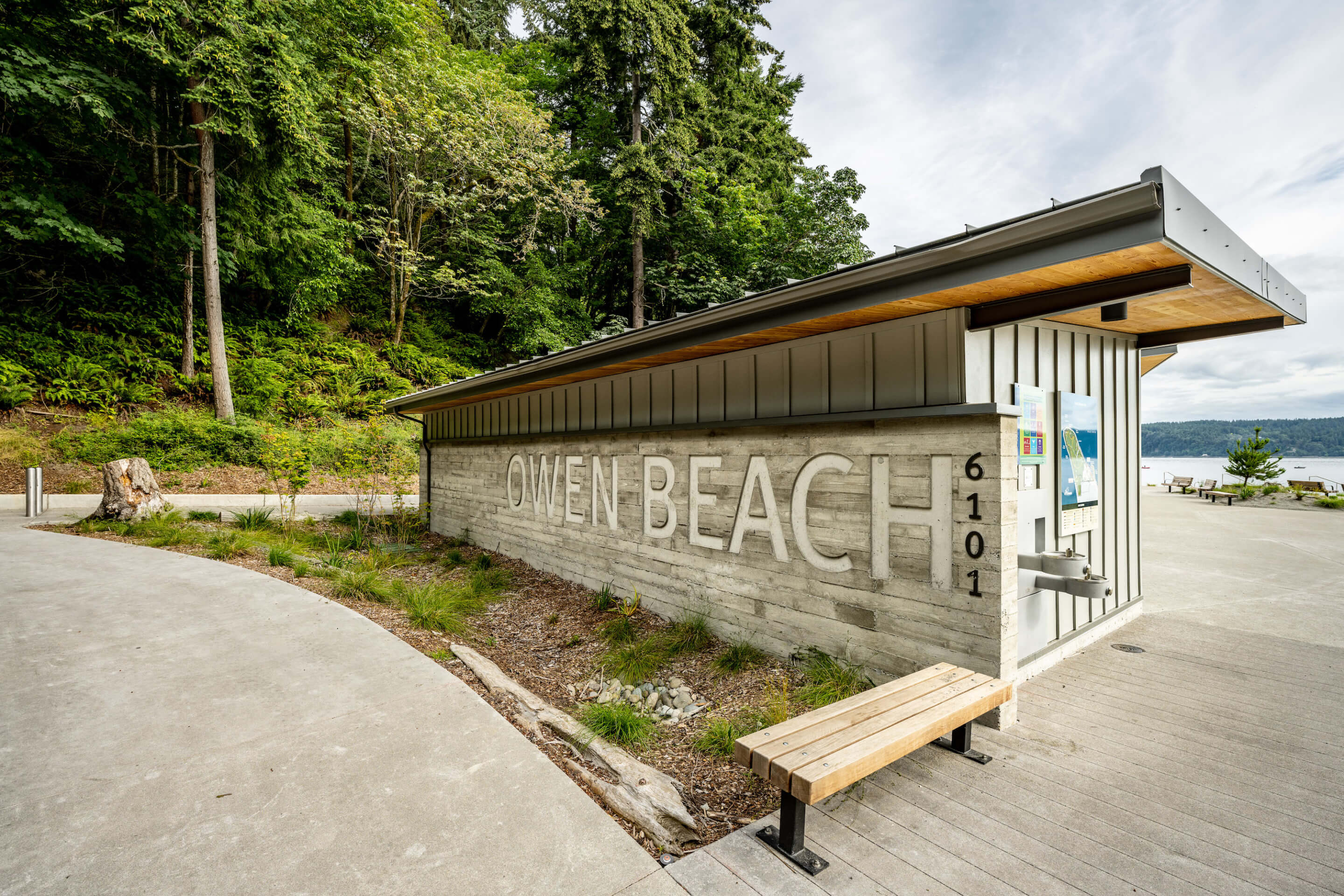
Although Beaudoin said that there was “no appetite” to raze the non-landmarked bathhouse building as part of the overhaul, it still may eventually come down. “It probably won’t stay there forever, Kristi Evans, capital program manager with Metro Parks Tacoma, explained. “It’s old and it still has issues, but for now it can stay.”
Further up into the hillside, the reconfigured (and re-striped) parking area boasts an increased capacity and an expanded beachfront drop-off and pick-up area; bioswales and other green infrastructural elements in the parking lot capture and treat runoff before it reaches the sound. Additionally, the curving one-way access road leading to the sloped parking lot has been modified to allow for two-traffic; what was once the entry-only section of the road has been converted into a trail for pedestrians and cyclists. (And then was the talk-of-town issue speed bump drama, which was rectified in July.)
Orca sculptures and beefed-up parking lots aside, the most consequential element of the bond-funded Owen Beach makeover won’t be obvious to most casual beachgoers. Regular visitors, however, will likely notice that the entire footprint of the beach has shifted away from the Puget Sound.
“You don’t feel further from the beach, even though you’re a lot further from the water,” Beaudoin explained.
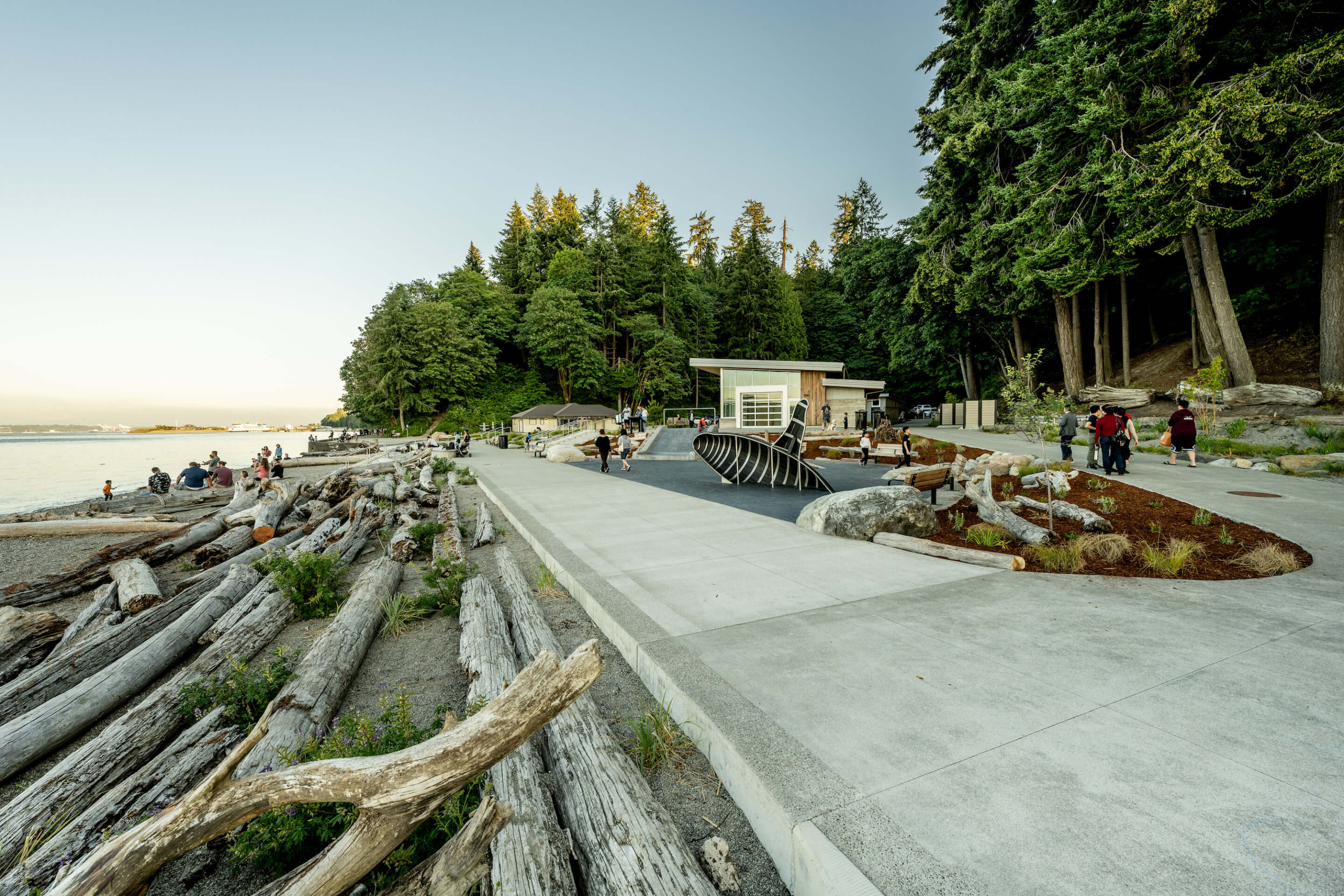
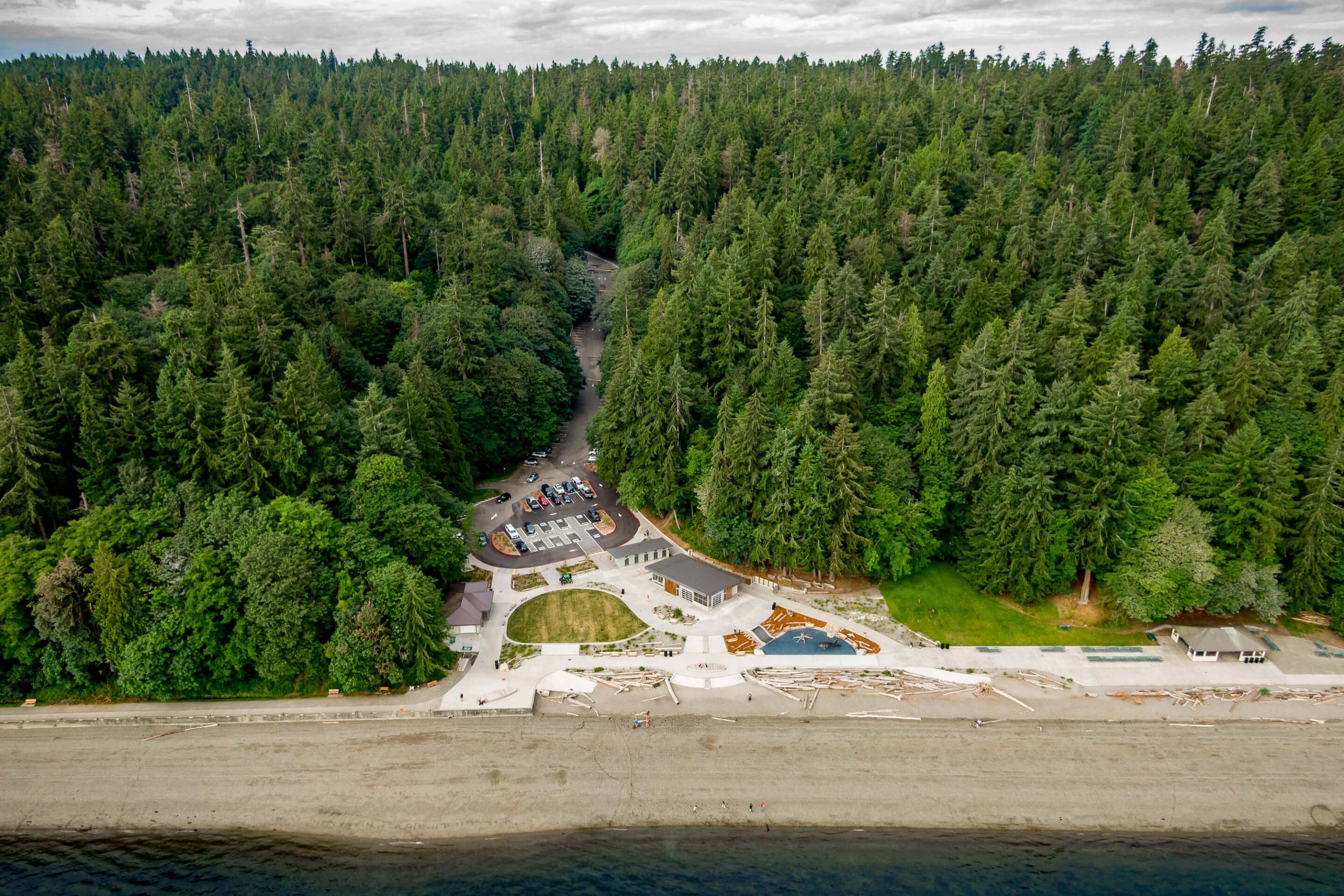
This retreat is based on sea level rise projections from the Washington Coast Resiliency Project, an undertaking of the University of Washington’s Climate Impacts Group. Per the projections, net sea level rise will increase by six feet by 2090. As a result, Owen Beach’s paved shoreline promenade, which stretches just under a mile to Point Defiance Mariana, has been pulled 18 feet inland. The lawn area shifted 34 feet inland and the parking lot is now at a remove of 57 feet with the new multi-purpose pavilion standing on what was once a portion of the lot.
“We took away from the beach area and pulled it back, and then we added more up on top,” Evans explained.
The Washington Sea Grant (WSG) program, based at the University of Washington, partnered with Site Workshop to help determine how far the beach’s public facilities needed to be pulled back from the shoreline.
“They’re [the WSG] helping planners and decision-makers to plan for sea level rise in a simple, methodical kind of way,” Beaudoin said.
The beach redesign’s status as a WSG pilot project was serendipitous. “This is the first project that I’d worked on that was really beach-oriented, and so I was thinking about sea level rise and reached out to Washington Sea Grant,” Beaudoin explained. As luck would have it, WSG had the funding to launch two pilot programs in Tacoma. It’s at this point the scope of the project evolved beyond straightforward building rehabs and infrastructural and accessibility upgrades.
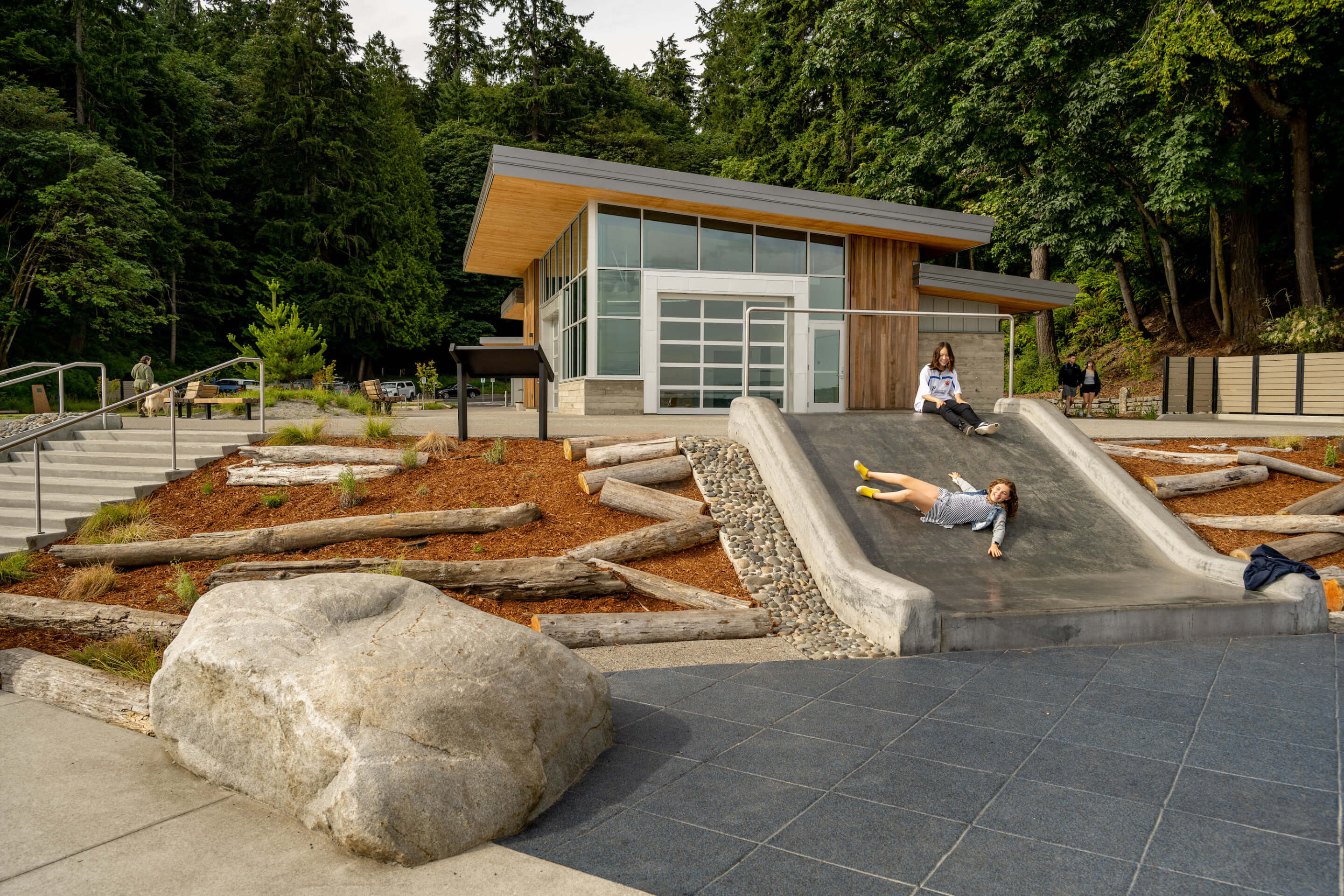
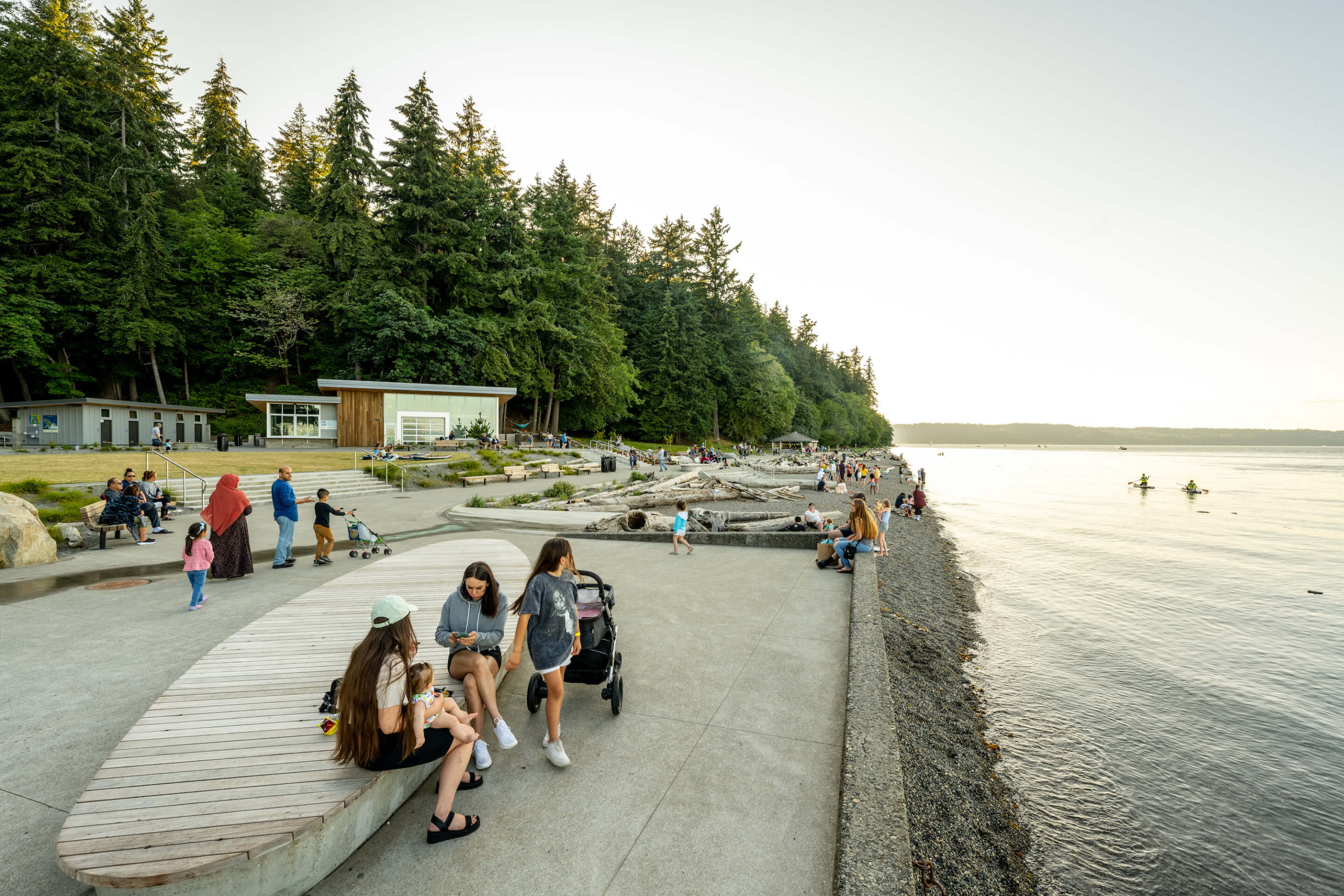
It might seem that Owen Beach effectively shrunk following the coastal resiliency-minded redesign. More accurately, it shifted—all without cutting into the adjacent hillside—in a puzzle-like feat of reconfiguration, reconstruction, and adaptive reuse that manages to stay within the same footprint of the old Owen Beach. The beach is also a culturally sensitive site for multiple Coast Salish nations, a factor that dictated much of how the beach was redesigned.
“With Site Workshop’s help, we went through several revisions of different designs, and came up with one that kept a lot of what was there, but just in a different way,” explained Evans.
This isn’t the first transformative project that Site Workshop has helmed at Point Defiance. The award-winning firm, perhaps best known for its work with NBBJ on the conservatory-esque Spheres that anchor Amazon’s downtown Seattle campus, also worked with Metro Parks on the 11-acre Dune Peninsula, a Superfund site-turned-public amenity that debuted in July 2019 in the far southeastern corner of the park near the Point Defiance Ferry Terminal. Featuring epic slides, sweeping views, paved trails, and a 600-foot-long pedestrian bridge linking Point Defiance with bustling Ruston Way, Dune Peninsula doesn’t borrow its name from the presence of wind-sculpted sandscapes. It was actually named in homage to the classic 1965 sci-fi novel by Tacoma native Frank Herbert. “It’s a place that has gone from spewing heavy metals to breathing life into our community,” wrote Metro Parks. “The real-life Dune shows that we can, if we want, restore our world and ourselves.” (The site was once home to the notorious Asarco copper smelter, demolished in 1993 to great local fanfare.)
Back at Owen Beach, accessibility, like climate resiliency, played a key role in the redesign. With new ramps leading down to the water, all park-goers now enjoy the same ease of access to the seaweed-strewn shoreline (and without the need to scramble over the beach’s characteristic driftwood in spots.) Along with accessible pathways and plazas, Site Workshop also added bump-outs to the reconstructed waterfront promenade so that, as Beaudoin explained, “even if you didn’t set foot on the beach, you could be here on this edge and have the beach behind you so that you’re enveloped.”


Enhanced beach access for beachgoers (including those hauling hand-carried watercraft) was especially vital for local Indigenous communities, including the Puyallup and Nisqually Tribes, who have frequented Owen Beach for centuries. In addition to being a destination for potlatches and ceremonial gatherings, Owen Beach is also a meeting spot on Canoe Journey, a traditional trek stretching from the South Puget Sound to British Columbia.
“The process of engaging the tribes was collaborative and changed how Metro Parks incorporates tribal input into their projects,” Beaudoin said. “It was a really important part for this project because of their historic use of the beach.”
“They’re very happy with this design because […] our efforts to improve accessibility for people with mobility challenges serve their elders very well,” he added. “There were a lot of shared goals there.”
Beyond its cultural importance to the Coast Salish people, Owen Beach has enjoyed wildly varied community usage over the years, accommodating both party-ready crowds and solace-seekers in equal measure. The new Owen Beach continues to cater to both. As Evans noted, the beach attracts “not just salmon bakes and big parties, but people who go down there to have a little bit of quiet.” She also explained that the new children’s play area with its Highwire-designed climbable orca was kept simple and small so that the main event at Owen Beach would remain, well, the beach. “It’s not a destination playground—it’s Owen Beach,” she said.
The public “wanted to be able to use the park how they have always been using it, and how it always has been used even before Westerners showed up,” Beaudoin added. “This has always been a place of gathering and sharing food and big, big groups—and so that was really important.”
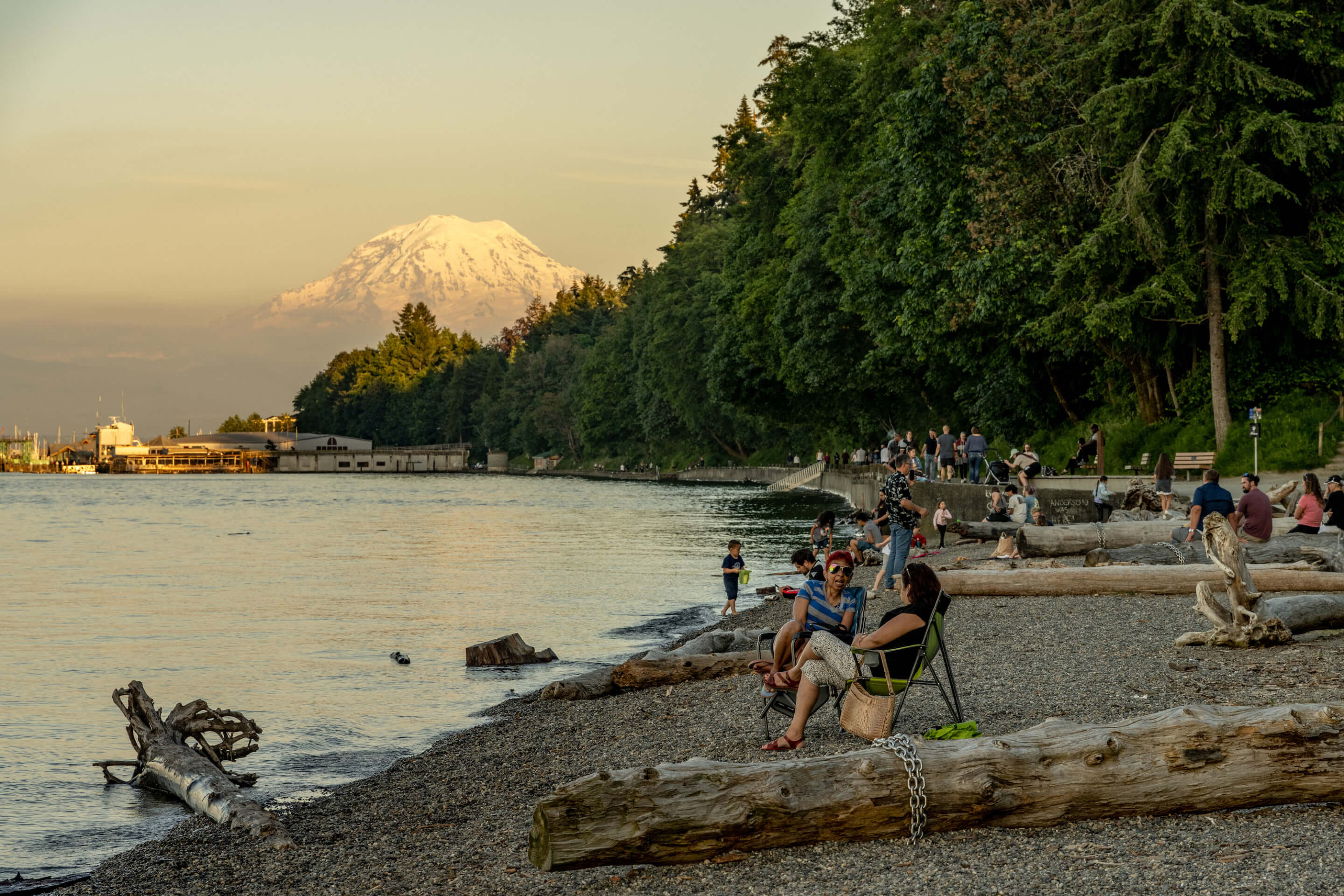
For an urban park as sprawling and storied as the 134-year-old Point Defiance, change has been plentiful over the decades: landscapes once blighted by industry have been renewed, landmark structures have been revived, longtime fixtures have been lost to fire, and enchanted woodland amusements have been reclaimed by Mother Nature. Prompted by crumbling cliffs and rising seas, this year’s dramatic changes—the closure of Five Mile Drive’s outer loop to motorized traffic and the unveiling of a transformed-yet-familiar beach—mark a new and more resilient era of change for the park.
While Metro Parks mulls methods of safely reintroducing motorized access to the sylvan outer reaches of Point Defiance in a way that benefits all park-users with minimal ecological disruption (reestablishing an old service road that bisects the tip of the peninsular park for public use is one option), down at Owen Beach visitors are arriving—and in droves—to the fiercely beloved space, one improved with the simple mission to “not screw it up.”
“This park is so well-loved, and I think that’s why people didn’t like to see change,” said Evans, who said that there have been some grumbles, an aspect that comes with the territory when bringing change to a public space that hasn’t been altered in years. “But the amount of people coming down to the beach now that it’s finally back open is incredible. I think it’s still as well-loved and, in most circles, I think we did what they asked for.”
Photos: © Stuart Isett/Courtesy Site Workshop









